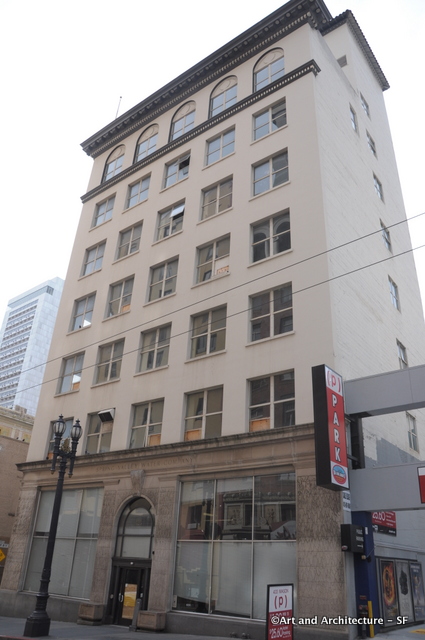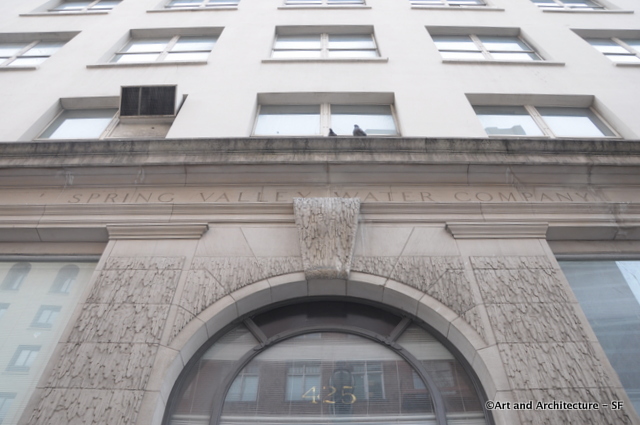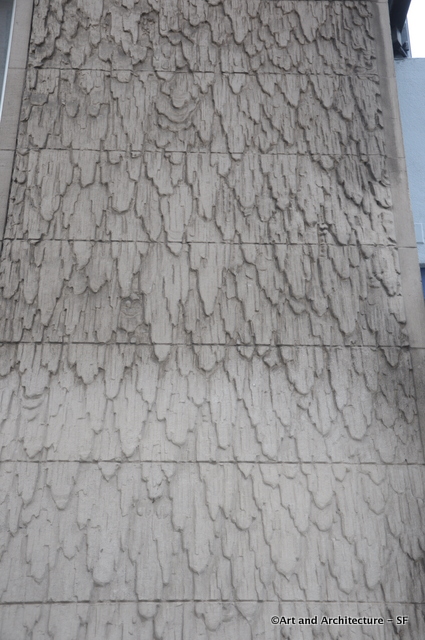425 Mason Street
Lower Nob Hill/Tenderloin
This unassuming and yet intriguing little building has been sitting in my computer waiting to be written about since March of 2012. My late husband, the architectural sculptor Michael H. Casey had driven me by to show me the wonderful detailed sculpture that covered the first floor. I was unable to find out anything about it and so the post was left unwritten.
In the past few months I had the privilege of hearing Gray Brechin, UC Berkeley lecturer and author, speak on the architecture of the UC campus. I purchased his highly detailed tome titled “Imperial San Francisco: Urban Power, Earthly Ruin‘” to further my education on San Francisco’s history. He has chapters dedicated to the fights and corruption of water and its history within our fair city. Most San Franciscan’s familiar with their city’s history know of the fight to bring water to a sea surrounded town, but Gray brings it to life with some underbelly stories that make reading his book worth every second.
An excerpt from the book:
Between the mid 1860s and 1930, San Francisco’s water supply was controlled by the Spring Valley Water Company. As one of the most powerful private monopolies in the state, Spring Valley was controlled by, and used largely for the benefit of, the local land barons and financiers who authorized the development of a wide variety of often-destructive hydrologic projects. Efforts to de-privatize the city’s water supply began under the Progressive mayoral administration of James Phelan, and pressure mounted after the failure of the water supply during the 1906 Earthquake and fire. Eventually the Hetch Hetchy source was secured for the city, ending Spring Valley’s corrupt monopoly.
The Spring Valley Water Company was a private company that held a monopoly on water rights in San Francisco from 1860 to 1930. Run by land barons, its 70-year history was fraught with corruption, land speculation, favoritism towards the moneyed elite, and widespread ill will from the general populace.
***
And yet, that is not what led me to write this post. In researching the First National Bank I took quite a long time to find the artist of the canopy over the side entrance to the bank. Emily Michels was a school teacher in San Francisco, and thus did not warrant much space on the hundreds of art sites dedicated to finding artists in the world. However, again thanks to the UC Bancroft Library, none-the-less, I found her.
It was in reading an interview with her that I discovered she was the one responsible for the water pouring down the Spring Valley Water Company building.
The building was designed by Willis Polk, who was a specialist in public-utility architecture and one of San Francisco’s leading architects. He was the architect on the Central Pump Station in San Francisco.
I found this excerpt about the building in The San Francisco Water, Volumes 1-8 dated January 1923
“The first two stories and part of the third will be devoted to the Water Sales Department. The fourth story will house the Agricultural Photographic, Publicity, Purchasing and Real Estate departments. The fifth will be occupied by the executive offices of the president and vice-president and manager. The sixth will be given over to the offices of the secretary and auditor. The top floor will accommodate the Engineering Department.
On the roof there will be a girls’ restroom, with a kitchen, set in the midst of a garden planted to grass and flowers, the latter being an unusual feature for the office building. The distinctive feature of the main floor will be a fountain designed by the distinguished sculptor, Arthur Putnam.
The public spaces in the building will have marble floors and wainscotings. The woodwork throughout will be oak. An intercommunicating Dictograph system will be installed to relieve the pressure on the telephone exchange.”
***
It is interesting that Arthur Putnam also was a sculptor on the First National Bank.
The City and County of San Francisco acquired the property on March 3, 1930 when it purchased Spring Valley Water Company’s water system. The building served as headquarters for the San Francisco Water Department until January 2003. The City declared the property surplus and placed it on the market in June 2007 at that time the sale price was $5,600,000.



VERY interesting! Truly enjoyed the information…
Your blog points out that we often look but do not see. Thanks for helping to keep architectural history alive!
I love the effect of water flowing down the sides of the building! And more great info.